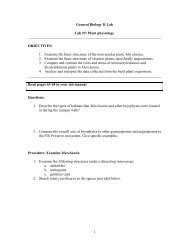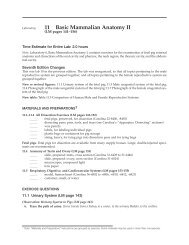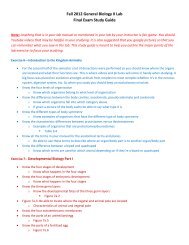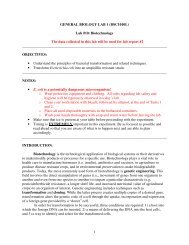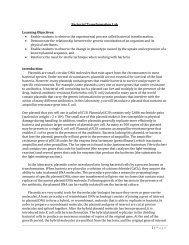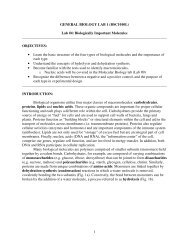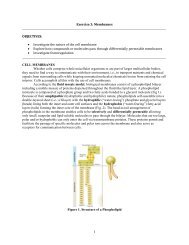Human Biology Lab Study Guide
Human Biology Lab Study Guide
Human Biology Lab Study Guide
- No tags were found...
Create successful ePaper yourself
Turn your PDF publications into a flip-book with our unique Google optimized e-Paper software.
The list of microscope parts and directions for focusing the microscope are onpage 15 of your lab manual.Inversion – the image in a microscope is upside down and reversed.To find the true magnification of a microscope, multiply magnification of theobjective and ocular lenses.Example: If your ocular lens is 40x and the objective lens is 100x, the overallmagnification is 40x100, or 4000x.1.4 Microscopic ObservationsAnimal vs. Plant cells.1) Animal cells have a plasma membrane while plant cells have a cell wall.2) Plant cells have chloroplasts to obtain energy from the sun while animalcells do not.3) Plant cells are rigidly stacked together while animal cells do not have ahigh level of organization.1.5 Animal Cell StructureA list of organelles in an animal cell is found on page 35 of your lab book.1.6 The plasma membraneTonicityIsotonic – Same amount of solutes inside and outside of the plasmamembrane. The potato remains the same as before it was placed in solution.Hypotonic – More solutes inside membrane, water rushes in to equilibrateconcentrations and the cell swells. In our case, the potato becomes very rigidfrom higher water concentration.Hypertonic – More solutes outside the membrane, water rushes out toequilibrate concentrations and cell shrivels. The potato becomes very flaccidand weak.For more information, turn to page 38 of your lab manual.If we were to place red blood cells in a…Hypotonic solution – water would rush in to the blood cells and burst(hemolysis) making in possible to see through the test tube.Hypertonic solution – water would rush out of the blood cells and shrivelthem, but not to the point that the test tube would be clear.Isotonic solution – the cells would be in equilibrium with theirsurrounding environment, causing no change and making it impossible to seethrough the test tube.For more information, refer to page 39 of your lab manual.



